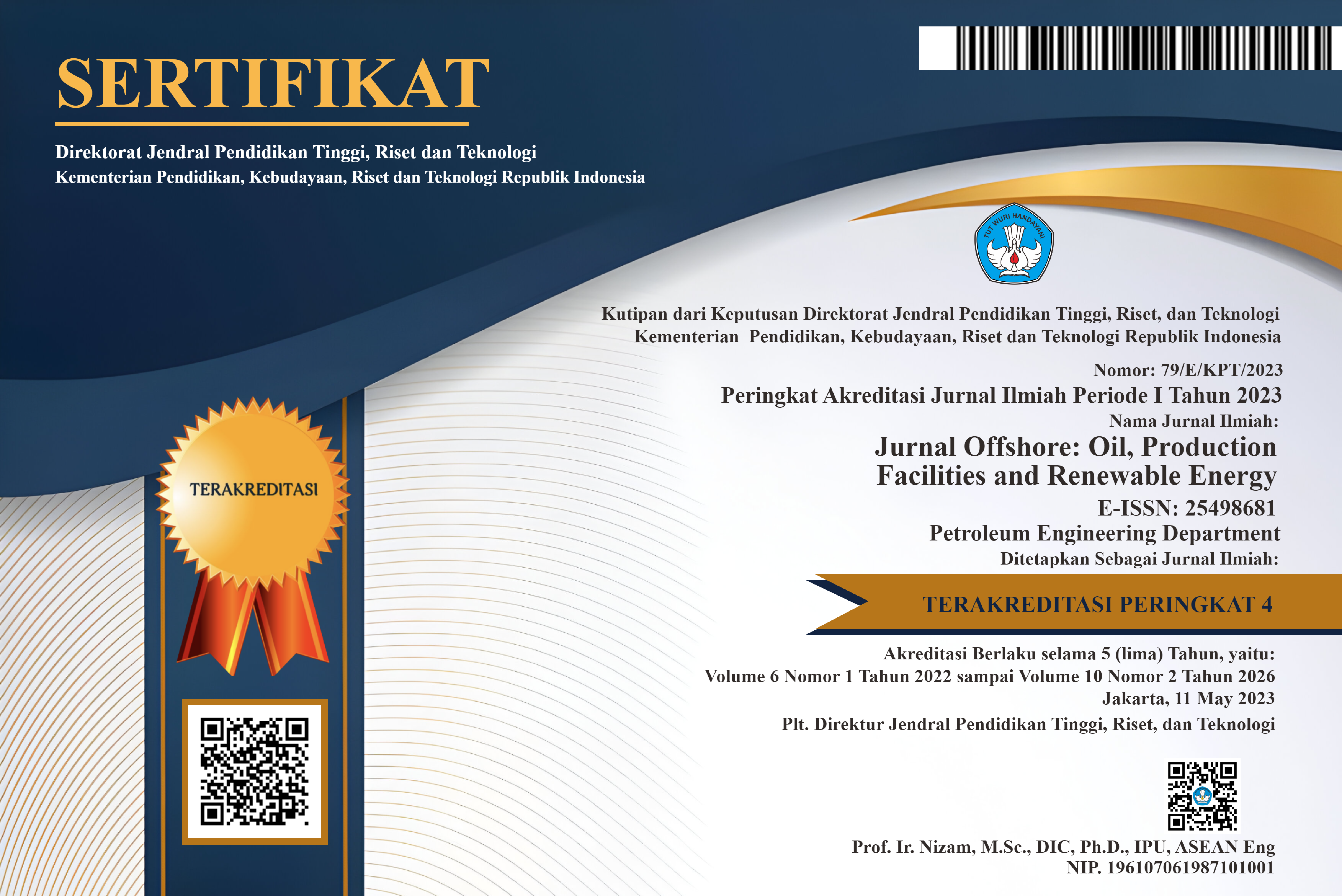Kajian Potensi Panas Bumi Sebagai Renewable Energy dan Pemanfaatanya pada Daerah Prospek Panas Bumi Gunung Telomoyo Magelang
DOI:
https://doi.org/10.30588/jo.v6i2.1217Keywords:
energi terbarukan, manifestasi, panas bumi, TelomoyoAbstract
Abstrak
Energi konvensional merupakan sumber energi utama yang masih digunakan hingga saat ini, seperti batubara dan minyak bumi. Namun, sumber energi tersebut jumlahnya semakin menipis karena tidak bisa untuk diperbarui dan memerlukan waktu yang lama dalam pembentukannya, sedangkan kebutuhan energi yang selalu meningkat. Sehingga, dibutuhkan sumber energi baru dan terbarukan yang berkelanjutan, salah satunya adalah energi panas bumi. Potensi panas bumi di Indonesia sangat tinggi, sekitar 40% atau 29.000 MW total panas bumi dunia berada di Indonesia, salah satunya di komplek Gunung Telomoyo. Penelitian bertujuan untuk mengindikasikan potensi persebaran dan karakteristik sumber energi panas bumi Telomoyo agar dapat dikembangkan lebih lanjut ke tahap eksplorasi dan eksploitasi. Metode penelitian berupa studi literatur dan survei lapangan untuk mendapatkan data sekunder dan primer. Dari penelitian ini, didapatkan hasil berupa titik persebaran manifestasi panas bumi, peta geologi, peta geomorfologi, potensi, dan karakteristik panas bumi di komplek Gunung Telomoyo. Terdapat tiga sumber manifestasi panas bumi, diantaranya yaitu berada di mata air panas Candi Dukuh, Pakis Dadu, dan Candi Umbul, dengan karakteristiknya yang didukung oleh data geokimia, geologi, dan geomorfologi. Panas bumi daerah ini berpotensi untuk substitusi energi konvensional dan juga potensial untuk eksplorasi dan eksploitasi, maka dari itu diperlukan studi lebih lanjut untuk optimalisasi sumber panas bumi di Gunung Telomoyo.
Kata kunci : manifestasi, panas bumi, Telomoyo
Abstrack
Energy is something that cannot be separated from human life. Over time, conventional energy such as coal and oil will be depleted because it takes a very long time to produced. To meet the increasing demand for the higher energy, new sustainable energy sources are needed. Renewable energy has a very high potential but its utilization is not optimal. One of the renewable energy sources is geothermal. Geothermal is a source of heat energy that is formed naturally below the earth's surface which comes from heating rocks and water along with others elements originating from magmatism activity in the earth's crust. Indonesia has the largest geothermal potential in the world because it’s located in the Indo-Australian and Eurasian subduction zones, leaving many active volcanoes and their potential. The Mount Telomoyo complex is one of the geothermal prospect areas which is indicated by the appearance of manifestations to the surface as hot springs and alteration of rocks. In the geothermal area of Mount Telomoyo, there are 3 heat sources as manifestations, including the hot springs of Candi Dukuh, Pakis Dadu, and Candi Umbul. In this study, field survey methods and literature studies were used which in the end obtained results in the form of distribution points of manifestations, geological maps, landform maps, and geothermal potential.
Keywords : manifestation ,geothermal, , Telomoyo,
References
Agista, Zendi, Prakosa Rachwibowo, And Yoga Aribowo. 2014. “Analisis Litologi Dan Struktur Geologi Berdasarkan Citra Landsat Pada Area Prospek Panasbumi Gunung Telomoyo Dan Sekitarnya, Kabupaten Magelang, Provinsi Jawa Tengah.” Geological Engineering E-Journal 6(1):278–93.
Agustiyar, Fandika. 2021. “Indications Of The Potential Of Shale Gas For Non-Conventional Energy Sources In Indonesia.” Tadulako Science And Technology Journal 2(1):17–25.
DEN. 2019. Outlook Energi Indonesia (OEI) 2019. Jakarta: Sekretariat Jenderal Dewan Energi Nasional.
DITJEN EBTKE. 2020. “Potensi Besar Belum Termanfaatkan, 46 Proyek Panas Bumi Siap Dijalankan.” Direktorat Jenderal Energi Baru Terbarukan Dan Konservasi Energi (EBTKE). Retrieved (Https://Ebtke.Esdm.Go.Id/Post/2020/03/27/2518/Potensi.Besar.Belum.Termanfaatkan.46.Proyek.Panas.Bumi.Siap.Dijalankan).
Farras, Naufal, Abdi Sukmono, And Nurhadi Bashit. 2017. “Analisis Estimasi Energi Panas Bumi Menggunakan Citra Landsat 8 (Studi Kasus: Kawasan Gunung Telomoyo).” Jurnal Geodesi Undip 6(4):371–80.
Hadimuljono, M. Basuki, Paulus Kurniawan, And Wartono Rahardjo. 2018. Geothermal Economics Handbook In Indonesia-Peluang Dan Tantangan. Penerbit Andi.
Hermawan, Dudi, And Yuan
no Rezky. 2011. “Delineasi Daerah Prospek Panas Bumi Berdasarkan Analisis Kelurusan Citra Landsat Di Candi Umbul-Telomoyo, Provinsi Jawa Tengah.” Buletin Sumber Daya Geologi 6(1):1–10.
Hermawan, Dudi, Sri Widodo, And Eddy Mulyadi. 2012. “Sistem Panas Bumi Daerah Candi Umbul-Telomoyo Berdasarkan Kajian Geologi Dan Geokimia.” Buletin Sumber Daya Geologi 7(1):1–6.
KESDM. 2022. Energi Baru Terbarukan Berperan Besar Dalam Upaya Penurunan Emisi Di Sektor Energi. Pers. 351.Pers/04/SJI/2022. KEMENTERIAN ENERGI DAN SUMBER DAYA MINERAL.
Ramadhan, Nadiar, Mutya Prameswari, And Agung Harijoko. 2014. “EVALUASI KONDISI GEOLOGI DAN GEOKIMIA POTENSI PANASBUMI GUNUNGAPI TELOMOYO.” Pp. 447–58 In PROSIDING SEMINAR NASIONAL KEBUMIAN KE-7. Yogykarta: Jurusan Teknik Geologi, Fakultas Teknik, Universitas Gadjah Mada.
Sundus, Balqis Humairoh. 2020. “Identifikasi Struktur Bawah Permukaan Daerah Prospek Panas Bumi Dengan Metode Geomagnetic: Studi Kasus Di Daerah Mata Air Panas, Desa Padusan, Kecamatan Pacet, Kabupaten Mojokerto.”
Downloads
Published
How to Cite
Issue
Section
License
Authors retain copyright and grant the Jurnal Offshore right of first publication with the work simultaneously licensed under a Creative Commons Attribution 4.0 International License that allows others to share (copy and redistribute the material in any medium or format) and adapt (remix, transform, and build upon the material) the work for any purpose, even commercially with an acknowledgement of the work's authorship and initial publication in Jurnal Offshore. Authors are able to enter into separate, additional contractual arrangements for the non-exclusive distribution of the journal's published version of the work (e.g., post it to an institutional repository or publish it in a book), with an acknowledgement of its initial publication in Jurnal Offshore. Authors are permitted and encouraged to post their work online (e.g., in institutional repositories or on their website) prior to and during the submission process, as it can lead to productive exchanges, as well as earlier and greater citation of published work (See The Effect of Open Access).















